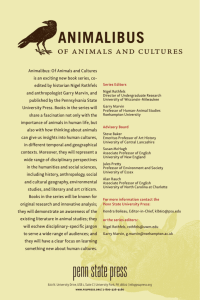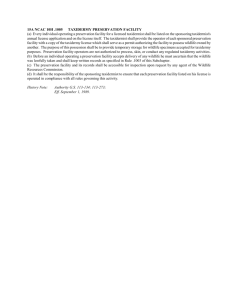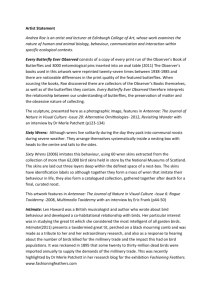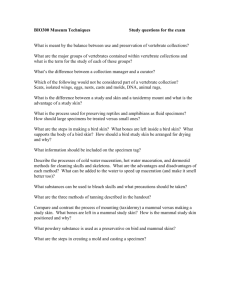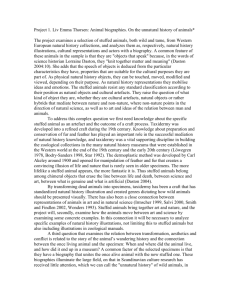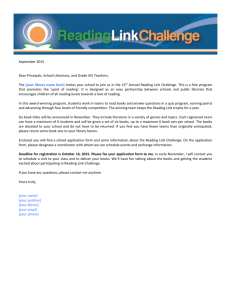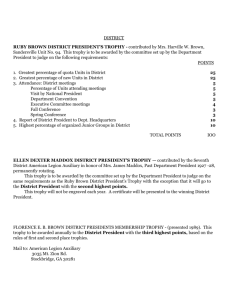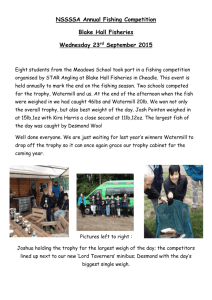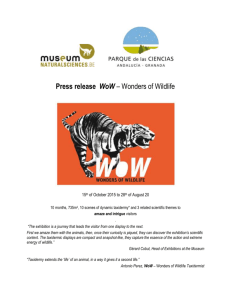Catalogue essay: Something's gone wrong again: Art, animals
advertisement
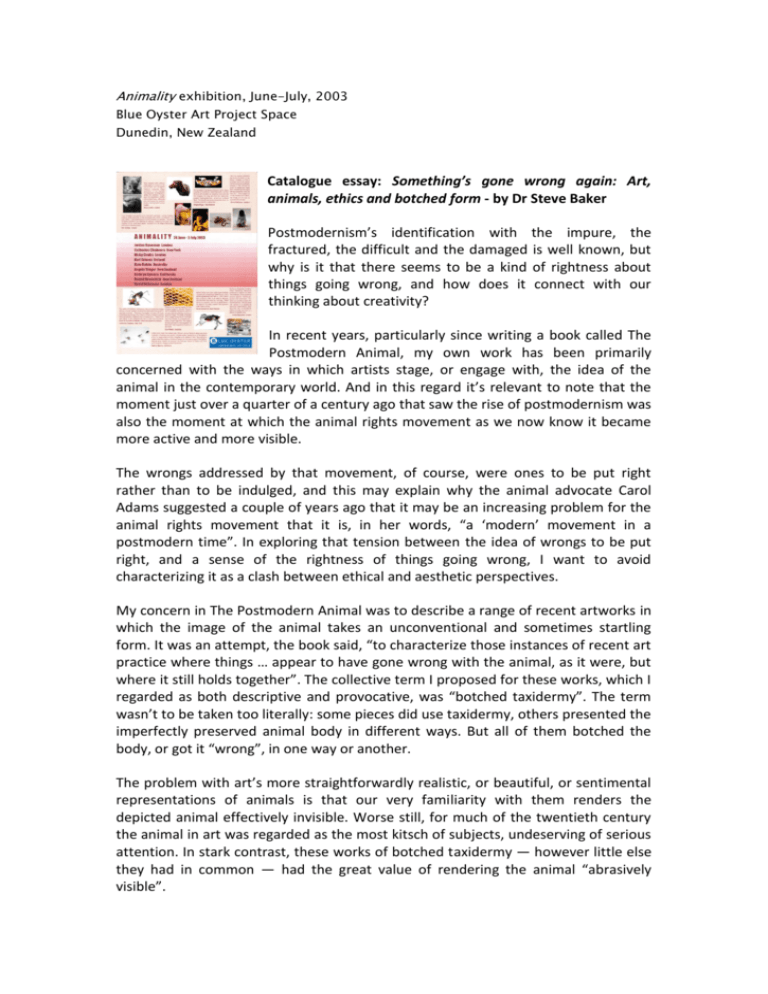
Animality exhibition, June-July, 2003 Blue Oyster Art Project Space Dunedin, New Zealand Catalogue essay: Something’s gone wrong again: Art, animals, ethics and botched form - by Dr Steve Baker Postmodernism’s identification with the impure, the fractured, the difficult and the damaged is well known, but why is it that there seems to be a kind of rightness about things going wrong, and how does it connect with our thinking about creativity? In recent years, particularly since writing a book called The Postmodern Animal, my own work has been primarily concerned with the ways in which artists stage, or engage with, the idea of the animal in the contemporary world. And in this regard it’s relevant to note that the moment just over a quarter of a century ago that saw the rise of postmodernism was also the moment at which the animal rights movement as we now know it became more active and more visible. The wrongs addressed by that movement, of course, were ones to be put right rather than to be indulged, and this may explain why the animal advocate Carol Adams suggested a couple of years ago that it may be an increasing problem for the animal rights movement that it is, in her words, “a ‘modern’ movement in a postmodern time”. In exploring that tension between the idea of wrongs to be put right, and a sense of the rightness of things going wrong, I want to avoid characterizing it as a clash between ethical and aesthetic perspectives. My concern in The Postmodern Animal was to describe a range of recent artworks in which the image of the animal takes an unconventional and sometimes startling form. It was an attempt, the book said, “to characterize those instances of recent art practice where things … appear to have gone wrong with the animal, as it were, but where it still holds together”. The collective term I proposed for these works, which I regarded as both descriptive and provocative, was “botched taxidermy”. The term wasn’t to be taken too literally: some pieces did use taxidermy, others presented the imperfectly preserved animal body in different ways. But all of them botched the body, or got it “wrong”, in one way or another. The problem with art’s more straightforwardly realistic, or beautiful, or sentimental representations of animals is that our very familiarity with them renders the depicted animal effectively invisible. Worse still, for much of the twentieth century the animal in art was regarded as the most kitsch of subjects, undeserving of serious attention. In stark contrast, these works of botched taxidermy — however little else they had in common — had the great value of rendering the animal “abrasively visible”. It was their wrongness that gave them their edge. In botching the body, in calling into question the categories and the boundaries of the human and the nonhuman, the pure, the perfect, the whole, the beautiful and the proper, they held out the promise of an art, to borrow Adam Phillips’s tantalizing words, in which “the idea of human completeness disappears”, and whose difficult effect might also offer what he calls “good ways of bearing our incompleteness”. Botching is a creative procedure precisely because of its openness to getting things wrong. Instead of offering answers, these works of botched taxidermy were, I suggested, “questioning entities”. Phillips, again, praising “the fluency of disorder, the inspirations of error”, argues: “We need a new pantheon of bunglers”. I’m not insensitive to the peculiarity of the position I appear to be adopting here. A recent British newspaper headline, quoting Sean Gifford, a member of People for the Ethical Treatment of Animals who’s been disrupting Paris fashion shows that have prominently featured furs, read: “There is nothing creative about skinning an animal”. I agree with this, but would still want to argue that works of botched taxidermy, some of which prominently feature skinned animals, are indeed creative. It was not my intention to engage in direct ethical judgements about these sometimes highly contentious works. Some of the pieces, such as Jordan Baseman’s sculptural pieces using animal skins and basic taxidermy techniques, seemed to me to be defining images of the 1990s that help us to think through our inevitably contradictory relation to the other-than-human or more-than-human world. Works by some other artists were undoubtedly more problematic. But it seemed important to defend these works, regardless of what I thought of them individually. I wanted to defend them in order to observe them, to allow them space to be, to trust their integrity, to see what they might have in common, and how they might work beyond their makers’ varied intentions and varied engagements with animals. It hardly needs saying that this is not a culture that trusts art, or trusts artists, to operate with integrity. And that lack of trust shows this culture at its least creative: you can’t have an untrusting account of creativity. The difficulty is that this necessary trust has to sit alongside, and somehow to accommodate, the fact that artists have sometimes harmed animals in making their work, whether (to cite three notorious examples) in the construction of devices to zap thousands of flies, or the invitation to gallery-goers to decimate goldfish in kitchen blenders, or the liberties taken with the life of a genetically modified rabbit in the name of art. The seriousness of the work cannot excuse or justify the harm. In that sense, the artist Sue Coe’s maxim, “life before art”, has to be right. But that is an argument for another occasion, because the criticisms of botched taxidermy are of a different order. I’m aware of three principal objections that have been raised to this kind of work: first, that critical responses to this art gloss over the contentious fact that many of the works consist of real, damaged, animal bodies; second, that the works are unremittingly ugly; and third, that they’re ethically irresponsible. The difficulty is therefore both with the look of this work, and with how the significance of that look is to be interpreted. The first objection is plainly put by John Simons, who has written: “When I see a work of ‘botched taxidermy’ … I do not see an epistemological problem. I see a dead animal”. More a than anything else, it was the need to address this uncompromising complaint that in fact prompted the present paper. But it is the third objection — the accusation of ethical irresponsibility — to which I need to attend most fully. It is articulated most forcefully by Anthony Julius, in his recent book Transgressions: The Offences of Art. Its central concern is to explore the “transgressive aesthetic” that runs through what Julius calls the “taboo-breaking art” of recent times. Rightly identifying the limitations of a formalist defence of this art, the particular and distinctive strength of the book is its insistence that both the form and content of this art should be taken seriously. As it happens, Julius discusses a few of the pieces I had called botched taxidermy in The Postmodern Animal. One is from Damien Hirst’s Natural History series (the animals preserved in formaldehyde); another is from Thomas Grünfeld’s Misfits series; and a third is John Isaacs’s Say It Isn’t So, in which the body of the mad scientist is a modified tailor’s dummy whose odd farmyard-animal-like head is in fact the wax cast of a frozen chicken. Julius seems to loathe these works, and is at his least persuasive in his interpretation of them. In them, he laments, “That most fundamental of hierarchies, which places the human above the merely animal, is subverted”. He specifically describes the pieces by Grünfeld and Isaacs as “counter-Enlightenment taunts”: “They present the monsters, the taxidermic aberrations, that a humanity unconstrained by moral scruple, basest when least confined, will produce … These man-beasts, minatory or comic, deny the divinity of the human form that is the premise of Western art”. This kind of hybrid, taboo-breaking art is an assault on its audience because, he writes, it “can force us into the presence of the ugly, the bestial, the vicious, the menacing. These are all kinds of cruelty”. Isaacs is the only one of those three artists I’ve had the opportunity to interview in person. His account of the “force” of the life-sized figure in Say It Isn’t So is rather different. Its effect, he hoped, would be to “force the viewer from their intelligence” and to take them unawares, prompting a moment of perplexity and non-recognition, of genuine thinking. More generally, he observed that much of his work “comes from trying to fit together different information sources — art, science, whatever — and allowing them to cohabit, coexist, to form more of a question than an answer”. A comparable point is made in an essay entitled “Lightness” by the late Italo Calvino, in which he noted that for Ovid “everything can be transformed into something else, and knowledge of the world means dissolving the solidity of the world. And also for him there is an essential parity between everything that exists, as opposed to any sort of hierarchy of powers or values”. This is, one might say, a collage principle. It is interested in things, it accepts things, in all their discontinuity and unevenness and unlikeliness, and this is what it works with, not knowing the outcome in advance. Collage is about putting the wrong things together: to the right effect. In his recent book Animals in Film, Jonathan Burt notes the extensive use of “a collage of effects” in the construction of apparently realistic animal imagery in film, adding the useful observation that “the ethical potential of animal films cannot necessarily be mapped onto their truth value”. A similar idea is borne out in Nicky Coutts’s striking series The Inheritors, where it often takes a moment to figure out what’s wrong, until it becomes apparent that those are human eyes collaged on to a variety of animal faces. It reminds me of the American artist Jim Dine’s wonderful comment: “I trust objects so much. I trust disparate elements going together”. In the light of these benign botchings, my criticism of Anthony Julius in his book Transgressions is not that he complacently assumes the superiority of human over nonhuman life (though he does seem to do that), but rather that he doesn’t trust artists. He can’t do so because he doesn’t seem to grasp that positive sense of botching. And his concern with “moral scruple” — like Suzi Gablik’s concern back in the 1980s with what she called “art’s moral centre” — only reinforces my view that the integrity of the artworks I’m describing is not fashioned out of, and is not best expressed through, the language of morals and ethics. Jacques Derrida’s essay “And say the animal responded?”, drawn from a long 1997 lecture and published for the first time earlier this year, opens with this question about the limits of ethics in the field of human-animal relations: “Would an ethics be sufficient … to remind the subject of its being-subject, its being-guest, host or hostage, that is to say its being-subjected-to-the-other, to the Wholly Other or to every single other?”. Derrida answers the question thus: “I don’t think so”. He continues to be wary, as he’s said before, of even a “provisional” morality. In contemporary art, the integrity I’m talking about might be thought of as a working method, an intuitive way of operating, in which there is often a precarious balance of confidence and not-knowing, or of confidence despite not-knowing. My original account of botched taxidermy itself implied a certain resilience, or integrity, or even dignity, in the way these botched bodies held together, against the odds. But precisely because botched form sails close to, and reconfigures much the same formal vocabulary as the so-called “abject art” of the early 1990s, with its apparent reveling in meat, baseness, powerlessness, and hierarchies, and awful lot depends on the effectiveness with which those meanings can be turned. The example I want to begin to explore in relation to this is the turning of the hunting trophy. The dead animal of botched taxidermy is not the dead animal of the hunting trophy, though each might be said to haunt the other. It was, I think, Jordan Baseman who first got me thinking about trophies. Talking about the pair of animal skins with modelled heads that comprise his stunning The Cat and the Dog, he described the effect of these wall-mounted bodily remains as being “exactly like tiger skins, or bear skins or whatever”. He also referred to them as “empty trophies”. That sense of an empty or subverted trophy is also explored in the work of the New Zealand-based artist Angela Singer. Since the mid-1990s she has been making a series of works that address the turning of taxidermic meaning even more explicitly. Motivated by a commitment to animal rights, Singer talks of her work as “recycled taxidermy”, and says: “I think using taxidermy is a way for me to honour the animals’ life, because all the taxidermy I use was once a trophy kill. … The very idea of a trophy animal is sickening to me”. In a work entitled Sore, which is also the Victorian name for a fallow deer, the skin has been removed from the trophy head, taking it back to the supporting taxidermic form, and a new “flesh” created by coating and carving red wax, iron oxide pigments and varnishes. Like many of her works, its look relates to the history of that particular individual animal. As the family that donated the trophy head to Singer had explained, both the hunter who shot it and the deer itself had been drenched in blood, because the antlers act as a blood reservoir and it spurts everywhere when, as happened here, they were sawn off. Of her practice as a whole, Singer says: “I think some people fear the physicality of art that uses taxidermy. Taxidermy shrinks the animal, and botching taxidermy gives the animal back its presence, making it too big to ignore”. In contrast to the celebratory rhetoric of the hunting trophy, works such as these leave the viewer disconcerted, unconfirmed. And in this, at least, John Berger’s famous claim that “no animal confirms man” seems to be borne out here. We come now to my rather odd conclusion, such as it is. Tom Robbins’s gloriously politically-incorrect novel, Fierce Invalids Home from Hot Climates, opens with a description of an aged parrot that “looked like a human fetus spliced onto a kosher chicken”. The book is full of botched bodies (both animal and human) which, though they include his own, seem in no way at odds with the placid philosophy of the central character, a maverick CIA agent called Switters, who sees true intelligence as always being “in the service of serenity, beauty, novelty, and mirth”. His outlook is shaped in no small part by his enthusiasm for a book on meditation called The Silent Mind. Curious to read something of the sort, having never done so, I’ve recently been dipping into a collection of talks on meditation by a Japanese Zen master called Shunryu Suzuki. I make no apology for taking some of its ideas wildly out of context, but I’ve been intrigued to find in it echoes of a couple of the ideas I’ve touched on in this paper. “The best way to control people is to encourage them to be mischievous”, says Suzuki: “first let them do what they want, and watch them. This is the best policy … to watch them, without trying to control them”. And calling into question the idea of failure, he refers to a Zen maxim he translates as “to succeed wrong with wrong” — the entirely permissible making of “one continuous mistake”. The striking thing is that this letting go of control, and toleration of operating continuously in the wrong, is explicitly characterized as “right practice”. I don’t want to draw any firm conclusion from this, but merely to observe with interest this perspective — far removed from postmodern theory — that seems able to acknowledge a rightness in the practice of things going wrong. That it does so in terms of encouraging mischief rather than being troubled by transgression is also gratifying: a distant echo, somehow, of the botching that trusts (in Dine’s words) “disparate elements going together”. Adapted from a paper given at the Research Centre in Creativity, London Metropolitan University, March 2003. Steve Baker is Professor of Art History in the Department of Humanities at the University of Central Lancashire. Author of “The Postmodern Animal and of Picturing the Beast: Animals, Identity, and Representation”.
